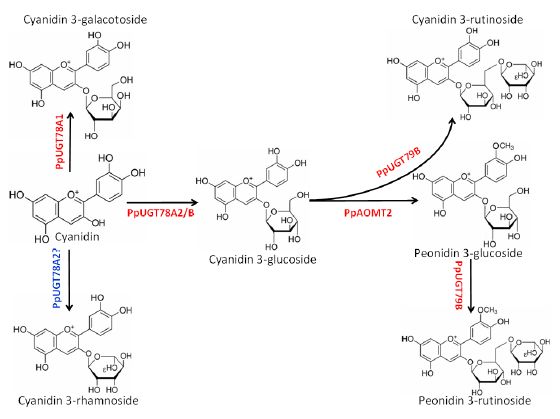
Mechanism of Anthocyanins Unraveled in Peach
Aug 20, 2014 Email"> PrintText Size

Peach [Prunuspersica L. (Batsch)] is the third most important fruit tree in the world. To date, there are few reports on genes involved in anthocyanin modifications in peach.
Dr. CHENG Jun, supervised by Prof. HAN Yuepeng of the Wuhan Botanical Garden, unraveled the mechanism underlying the glycosylation and methylation of anthocyanins in peach. This research, entitled “Unraveling the mechanism underlying the glycosylation and methylation of anthocyanins in peach”, has been accepted for publication by the leading international journal of Plant Physiology.
In this research, six anthocyanins in peach were identified. The structural diversity of those anthocyanins was proved to be attributed to glycosylation and methylation. Interestingly, in terms of anthocyanin composition in flowers, peach was quite similar to the wild species of P. ferganensis, but different from P. davidiana and P. kansueasis, indicating that peach was probably domesticated from P. ferganensis.
Subsequently, genes responsible for methylation and glycosylation of anthocyanins were identified. The spatial and temporal expression of those genes resulted in different patterns of anthocyanin accumulation in flowers, leaves, and fruits. Two tandem duplicated genes, PpUGT78A1 and PpUGT78A2, encoding flavonoid 3-O-glycosyltransferases (F3GT) in peach, showed different activity towards anthocyanin, providing an example of divergence evolution of F3GTs in plants. Two other genes, PpAOMT1 and PpAOMT2, encoding anthocyanin O-methyltransferases (AOMT), were expressed in leaves and flowers. However, only PpAOMT2 seems to be responsible for the O-methylation of anthocyanins at 3’ position in peach, according to the results.
In addition, this study revealed a novel family of UGT78 genes in plants, which lacks the highly conserved intron 2 of the UGT gene family, with a great variation of the amino acid residue at the position 22 of plant secondary product glycosyltransferase (PSPG) box.
This study provides novel insights in the mechanisms of anthocyanin glycosylation and methylation in peach, and will contribute in future to attempts of manipulation flavonoid biosynthesis for peach as well as other plants.
This research was supported by the National Program on Basic Research Project of China (973 Program) under grant No.2011CB100600 and the National program of China (No. 2011AA10020600-02).

A proposed model of glycosylation and methylation of anthocyanins in peach (Image by Dr. CHENG Jun)
Peach [Prunuspersica L. (Batsch)] is the third most important fruit tree in the world. To date, there are few reports on genes involved in anthocyanin modifications in peach.
Dr. CHENG Jun, supervised by Prof. HAN Yuepeng of the Wuhan Botanical Garden, unraveled the mechanism underlying the glycosylation and methylation of anthocyanins in peach. This research, entitled “Unraveling the mechanism underlying the glycosylation and methylation of anthocyanins in peach”, has been accepted for publication by the leading international journal of Plant Physiology.
In this research, six anthocyanins in peach were identified. The structural diversity of those anthocyanins was proved to be attributed to glycosylation and methylation. Interestingly, in terms of anthocyanin composition in flowers, peach was quite similar to the wild species of P. ferganensis, but different from P. davidiana and P. kansueasis, indicating that peach was probably domesticated from P. ferganensis.
Subsequently, genes responsible for methylation and glycosylation of anthocyanins were identified. The spatial and temporal expression of those genes resulted in different patterns of anthocyanin accumulation in flowers, leaves, and fruits. Two tandem duplicated genes, PpUGT78A1 and PpUGT78A2, encoding flavonoid 3-O-glycosyltransferases (F3GT) in peach, showed different activity towards anthocyanin, providing an example of divergence evolution of F3GTs in plants. Two other genes, PpAOMT1 and PpAOMT2, encoding anthocyanin O-methyltransferases (AOMT), were expressed in leaves and flowers. However, only PpAOMT2 seems to be responsible for the O-methylation of anthocyanins at 3’ position in peach, according to the results.
In addition, this study revealed a novel family of UGT78 genes in plants, which lacks the highly conserved intron 2 of the UGT gene family, with a great variation of the amino acid residue at the position 22 of plant secondary product glycosyltransferase (PSPG) box.
This study provides novel insights in the mechanisms of anthocyanin glycosylation and methylation in peach, and will contribute in future to attempts of manipulation flavonoid biosynthesis for peach as well as other plants.
This research was supported by the National Program on Basic Research Project of China (973 Program) under grant No.2011CB100600 and the National program of China (No. 2011AA10020600-02).

A proposed model of glycosylation and methylation of anthocyanins in peach (Image by Dr. CHENG Jun)
CAS Institutes
There are 124 Institutions directly under the CAS by the end of 2012, with 104 research institutes, five universities & supporting organizations, 12 management organizations that consist of the headquarters and branches, and three other units. Moreover, there are 25 legal entities affiliated and 22 CAS invested holding enterprisesThere are 124 I...>> more
Contact Us

Chinese Academy of Sciences
Add: 52 Sanlihe Rd., Xicheng District, Beijing, China
Postcode: 100864
Tel: 86-10-68597592 (day) 86-10-68597289 (night)
Fax: 86-10-68511095 (day) 86-10-68512458 (night)
E-mail: cas_en@cas.cn

